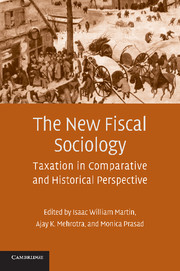26 results
Piketty and the Gilded Age
-
- Journal:
- The Journal of the Gilded Age and Progressive Era / Volume 19 / Issue 2 / April 2020
- Published online by Cambridge University Press:
- 26 February 2020, pp. 230-234
- Print publication:
- April 2020
-
- Article
- Export citation
The Power and Independence of the Federal Reserve. By Peter Conti-Brown. Princeton, NJ: Princeton University Press, 2016. 368p. $35.00 cloth.
-
- Journal:
- Perspectives on Politics / Volume 16 / Issue 4 / December 2018
- Published online by Cambridge University Press:
- 23 November 2018, pp. 1182-1183
- Print publication:
- December 2018
-
- Article
- Export citation
Systematic review of infant and young child complementary feeding practices in South Asian families: the India perspective
-
- Journal:
- Public Health Nutrition / Volume 21 / Issue 4 / March 2018
- Published online by Cambridge University Press:
- 23 November 2017, pp. 637-654
-
- Article
-
- You have access
- HTML
- Export citation
Systematic review of infant and young child complementary feeding practices in South Asian families: the Pakistan perspective
-
- Journal:
- Public Health Nutrition / Volume 21 / Issue 4 / March 2018
- Published online by Cambridge University Press:
- 20 November 2017, pp. 655-668
-
- Article
-
- You have access
- Open access
- HTML
- Export citation
6 - Mann on neoliberalism
- from Part II - Political, economic, military and ideological questions
-
-
- Book:
- Global Powers
- Published online:
- 05 April 2016
- Print publication:
- 18 April 2016, pp 107-116
-
- Chapter
- Export citation
Damien Cahill. The End of Laissez-Faire? On the Durability of Embedded Neoliberalism. Cheltenham, UK: Edward Elgar, 2014. xii +197 pages. ISBN: 978-1781000274, $110.00 (cloth).
-
- Journal:
- Enterprise & Society / Volume 16 / Issue 3 / September 2015
- Published online by Cambridge University Press:
- 03 June 2015, pp. 732-733
- Print publication:
- September 2015
-
- Article
- Export citation
11 - Avoiding the Aid Curse? Taxation and Development in Japan
- from Part Three - Legacies for Japan
-
-
- Book:
- The Political Economy of Transnational Tax Reform
- Published online:
- 05 May 2013
- Print publication:
- 22 July 2013, pp 289-305
-
- Chapter
- Export citation
Contributors
-
-
- Book:
- The Political Economy of Transnational Tax Reform
- Published online:
- 05 May 2013
- Print publication:
- 22 July 2013, pp vii-viii
-
- Chapter
- Export citation
The Popular Origins of Neoliberalism in the Reagan Tax Cut of 1981
-
- Journal:
- Journal of Policy History / Volume 24 / Issue 3 / July 2012
- Published online by Cambridge University Press:
- 12 June 2012, pp. 351-383
-
- Article
- Export citation
Tax “Expenditures” and Welfare States: A Critique
-
- Journal:
- Journal of Policy History / Volume 23 / Issue 2 / April 2011
- Published online by Cambridge University Press:
- 27 April 2011, pp. 251-266
-
- Article
- Export citation
Mark I. Vail (2010), Recasting Welfare Capitalism: Economic Adjustment in Contemporary France and Germany. Philadelphia: Temple University Press. £37, pp. 228, hbk.
-
- Journal:
- Journal of Social Policy / Volume 40 / Issue 2 / April 2011
- Published online by Cambridge University Press:
- 19 January 2011, pp. 420-422
- Print publication:
- April 2011
-
- Article
- Export citation
Robert E. Wright. One Nation Under Debt: Hamilton, Jefferson, and the History of What We Owe. New York: McGraw-Hill, 2008. 256 pp. ISBN 978-0071-54393-4, $27.95 (cloth).
-
- Journal:
- Enterprise & Society / Volume 11 / Issue 3 / September 2010
- Published online by Cambridge University Press:
- 18 February 2015, pp. 641-642
- Print publication:
- September 2010
-
- Article
- Export citation
11 - Taxation as a Regulatory Tool: Lessons from Environmental Taxes in Europe
-
-
- Book:
- Government and Markets
- Published online:
- 20 January 2010
- Print publication:
- 16 November 2009, pp 363-390
-
- Chapter
- Export citation
1 - The Thunder of History: The Origins and Development of the New Fiscal Sociology
-
-
- Book:
- The New Fiscal Sociology
- Published online:
- 13 January 2010
- Print publication:
- 13 July 2009, pp 1-28
-
- Chapter
- Export citation
Index
-
- Book:
- The New Fiscal Sociology
- Published online:
- 13 January 2010
- Print publication:
- 13 July 2009, pp 299-313
-
- Chapter
- Export citation
PART THREE - THE SOCIAL CONSEQUENCES OF TAXATION
-
- Book:
- The New Fiscal Sociology
- Published online:
- 13 January 2010
- Print publication:
- 13 July 2009, pp -
-
- Chapter
- Export citation
Acknowledgments
-
- Book:
- The New Fiscal Sociology
- Published online:
- 13 January 2010
- Print publication:
- 13 July 2009, pp ix-x
-
- Chapter
- Export citation
Frontmatter
-
- Book:
- The New Fiscal Sociology
- Published online:
- 13 January 2010
- Print publication:
- 13 July 2009, pp i-iv
-
- Chapter
- Export citation
List of Contributors
-
- Book:
- The New Fiscal Sociology
- Published online:
- 13 January 2010
- Print publication:
- 13 July 2009, pp vii-viii
-
- Chapter
- Export citation

The New Fiscal Sociology
- Taxation in Comparative and Historical Perspective
-
- Published online:
- 13 January 2010
- Print publication:
- 13 July 2009



